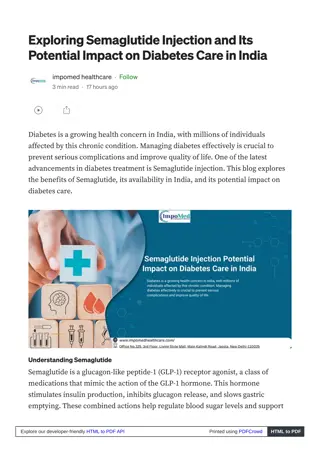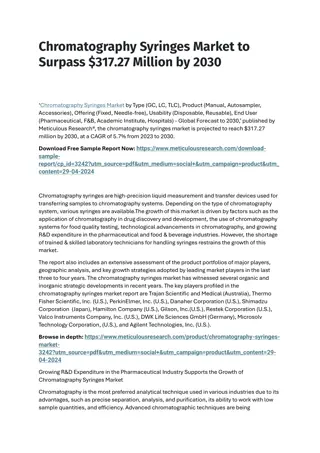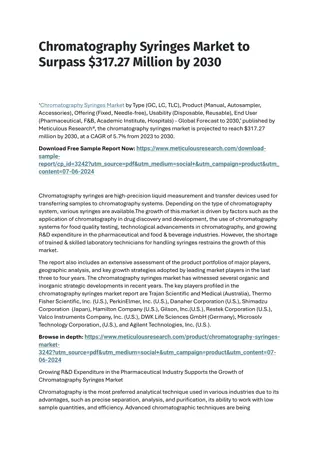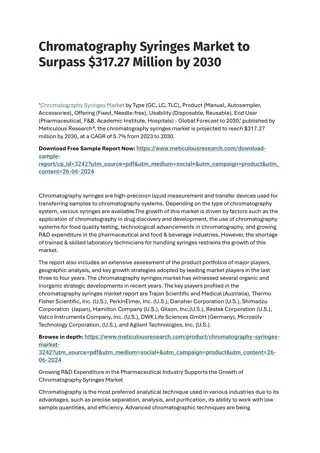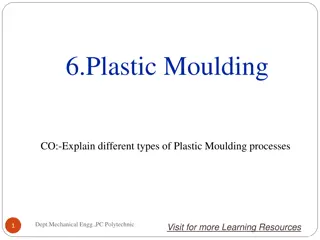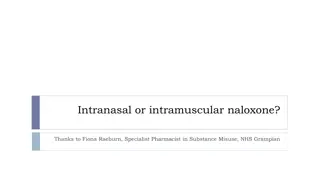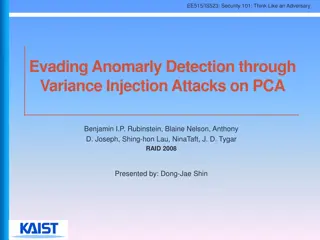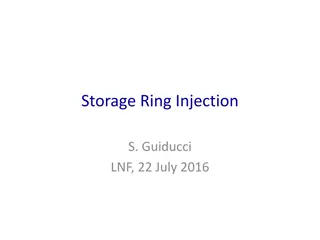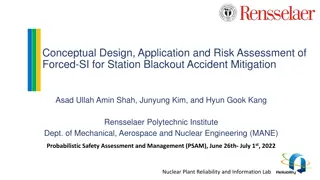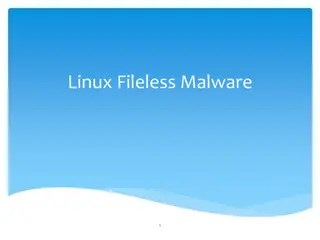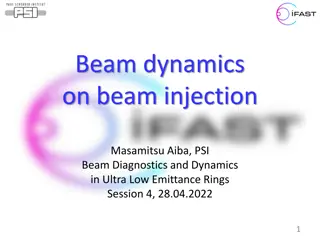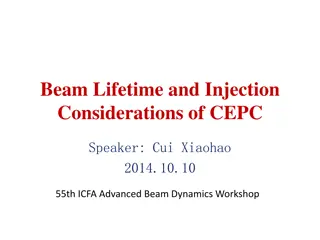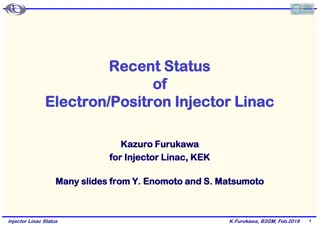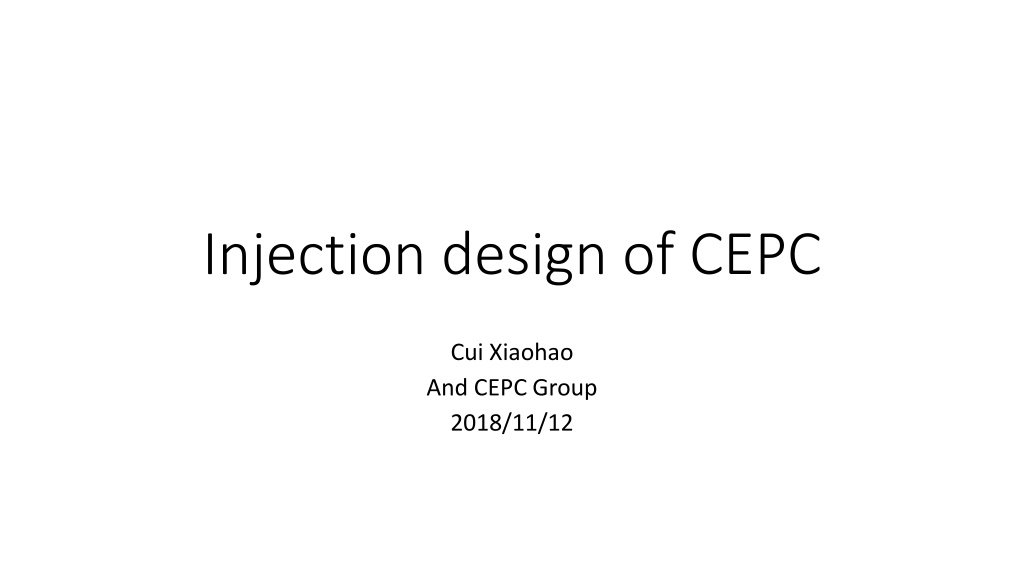
CEPC Injection System Design and Parameters
Explore the injection system design of the Circular Electron Positron Collider (CEPC) for high luminosity and different injection modes. Key parameters and injection time structures are discussed, along with details on Higgs, W, and Z injection modes, beam characteristics, and collider lifetime considerations.
Download Presentation

Please find below an Image/Link to download the presentation.
The content on the website is provided AS IS for your information and personal use only. It may not be sold, licensed, or shared on other websites without obtaining consent from the author. If you encounter any issues during the download, it is possible that the publisher has removed the file from their server.
You are allowed to download the files provided on this website for personal or commercial use, subject to the condition that they are used lawfully. All files are the property of their respective owners.
The content on the website is provided AS IS for your information and personal use only. It may not be sold, licensed, or shared on other websites without obtaining consent from the author.
E N D
Presentation Transcript
Injection design of CEPC Cui Xiaohao And CEPC Group 2018/11/12
1. Introduction: A Linac accelerate electrons and positrons to 10 GeV. A booster with the same circumference with the collider. For high luminosity, top-up injection is needed. For the simplicity and robustness of the injection system, a conventional off-axis injection is chosen as our baseline design. For Higgs mode, an swap-out on axis injection is chosen as another choice, in case of small DA in the collider.
Some key parameters of the collider ring Higgs W Z Energy (GeV) 120 80 45.5 Bunch number 242 1524 12000 Bunch Charge (nC) 24 19.2 12.8 Bunch Current (mA) 17.4 87.9 461 Revolution Period (ms) 0.3336 0.3336 0.3336 Emittance x/y (nm) 1.21/0.0031 0.54/0.0016 0.17/0.004 0.67 1.4 4 Life time (Hour)
2. Off-Axis Injection: Injection from Linac to booster Booster ramping to Extraction Energy repeat Booster ramping to 10 GeV Inject from booster to collider
Injection time structure: Different injection time Structure for different mode
This injection system fulfills the 3% top-up injection and full injection. Mode Higgs W Z Injection Mode Top-up Full Top-up Full Top-up Full Bunch number 242 1220 6000 Bunch Charge (nC) 0.72 1 0.72 1 0.384 0.55 Beam Current (mA) 0.5227 0.726 2.63 3.67 6.91 10 Current threshold 1 mA 4 mA 10 mA Number of Cycles 1 1 2 3% 3% 3% Current decay 10 6.6 3.8 Ramping Cycle (sec) (Up + Down Filling time (sec) e+ e-) 25.84 39.6 275.2 47 131 438 Injection period (sec) 10 min 15 min 2.2 Hour (collide from 230mA Full Injection time
For Higgs: x = 1.21 nm.rad; inject = 3.1 nm.rad x = 0.47 mm, _inject = 0.45 mm Septum = 2 mm X Bumped Stored beam Septum Injected beam Acceptance > 13 2mm X For W: x = 1.21 nm.rad; inject = 1.59 nm.rad x = 0.47 mm, _inject = 0.45 mm Septum = 2 mm Acceptance > 14 For Z: x = 0.17 nm.rad; inject = 0.51 nm.rad x = 0.18 mm, _inject = 0.16 mm Septum = 2 mm Bump Height Acceptance >4 xc+ 6 xi+ S Acceptance > 16
Current evolution in collider-Higgs Top up one injection (26s/35s) every 47s Full injection from empty 10 min Collider lifetime (non-collision) 924 hours: dominated Toucheck lifetime Top up Full injection
Current evolution in collider-W Top up one injection (46s) every 153s Full injection from empty 15 min Collider lifetime (non-collision) 105 hours: dominated Toucheck lifetime Top up Full injection
Current evolution in collider-Z Top up one injection (4.6min) every 7.3min Full injection from empty 2.2 hours (bootstrapping start from half of the design current) Collider lifetime (non-collision) 53 hours: dominated Toucheck lifetime Top up Full injection
Kickers and Septums for booster injection and extraction: Booster Injection Component Length (m) Waveform Deflection angle (mrad) Field (T) Beam-Stay- clear H(m m) 63 V(m m) 63 Septum 2 DC 9.1 0.152 Kicker 0.5 Half_sin 0.5 0.034 63 63 Booster Extraction Component Length (m) Waveform Deflection angle (mrad) Field (T) Beam-Stay- clear H(m m) 20 V(mm ) 20 Septum 10 DC 10.4 0.41 Kicker 2 Half_sin 0.2 0.04 20 20
Kickers and Septums for collider injection: Component Length (m) Waveform Deflection angle (mrad) Field (T) Beam-Stay- clear H(m m) 20 V(m m) 20 Septum 8.75 DC 14 0.64 Septum 8.75 DC 7 0.32 20 20 Septum 8.75 DC 3.5 0.16 20 20 Septum 8.75 DC 1.75 0.08 20 20 Kicker 2 Half_sin 0.1 0.02 20 20
3. On-Axis Injection: 1. Inject 242 small bunches into the booster. Linac booster collider 2. Ramp the booster to high energy and inject several (7 for example) bunches from the collider into the booster. Ramp up booster collider 3. Large bunches stay in the booster for 4 damping time(200ms), so that the injected bunches merge with booster bunches. booster collider Repeat 4. Inject the merged large bunches back to the same empty buckets left by the last step. booster collider 5. Repeat the last steps.
After 200ms4 damping time On-axis injection from booster to collider ring Off-axis injection from collider ring to booster Collider Ring Booster 0.070mA 0.068mA 0.068+0.002mA 0.068mA 0.002mA 0.002mA 0.068mA 0.068mA 242 bunches Booster 120GeV Ib=0.002mA 242-7 bunches Booster 120GeV Ib=0.002mA 242 bunches Booster 120GeV I=0.5mA+0.5mA 0.068+0.002mA 0.002mA 0.002mA 0.070mA 0.068mA 0.002mA 242 bunches Collider 120GeV Ib=0.068mA 242 bunches Collider 120GeV Ib=0.07mA 0.002mA 242-7 bunches Collider Ib=0.068mA 0.002mA 0.002mA 0.068mA 0.068mA 0.002mA 0.068mA 0.068mA 0.068+0.002mA 0.070mA Step 1 Step 2 Step 3 Merge bunches in the booster 1. The booster is used as an accumulator ring. 2. Inject the large bunch in the collider into the booster, not the other way around. 3. off-axis injection and bunch mergence are performed in the booster, whose dynamic aperture is large enough. 4. With this on-axis injection, the required dynamic aperture in the collider is only 8 x 5. For W, Z mode, the dynamic aperture in the collider is large enough, and we don t need this on-axis injection.
Y DA requirement: Off-axis 13 x X 15 y The required horizontal DA in the booster reduce from 13 x to 8 x. The required vertical DA also decrease a little. X Y On-axis 8 x X 15 y X
Time structure of the booster: Exchange bunches between the booster and collider 26 times. Injection cycles 3% current decay in the collider The small bunch charge in booster is 3% of the charge of the colliding bunch in the collider. With a 3% current decay, the injection period of CEPC should be less than 47s. Current limit in the booster The bunch charge in the collider is 24nC, which is less than the booster's single bunch charge limit of 100 nC. At the beginning, only 7 bunches are injected into the booster, so that the current in the booster does not exceed the 1mA threshold limited by the RF power. 5.2 s 5 s 5 s 2.4 s Linac to booster Ramp up Ramp down Positron injection Electron injection 35.2 s
Injection from the collider to booster Bunch before injection Bunch after injection Septum A vertical off-axis injection Transfer beam collider to booster vertically. 4-kicker bump in the booster. from the Septum kicker Phase space of the first 100 turns
Injection from booster to the collider Bunch before injection Bunch after injection A vertical on-axis injection Transfer beam back to the collider vertically. Septum Septum quad kicker Phase space of the first 100 turns
We need to inject the bunch back into the same bucket after damping in the booster. The booster and collider has the same circumference, which makes this easier. Due to the different paths traveled by the injection beam and the circulating beam, a longitudinal deviation is introduced. Longitudinal phase shift The length of the transport line is 261.2 meters, and the path difference between the injected beam and the circulating beam is only 0.011 meters, or 0.037 ns in time. This is equivalent to a 17 degree phase shift in the booster, and is in the stable region. This phase shift can be damped by synchrotron radiation. Or move the RF phase of the booster Did experiment at BEPC II, we found that 200 ms is enough to move a 17 degree. Booster 261.2 m 2.4 m collider 261.189 m
Beam loading effect is weak Transient beam loading in the booster by the injection of large bunch and larger current With 7 large bunches (0.07mA) evenly distributed among the other small bunches. Max cavity voltage drop is 0.48 %. Max phase shift is 0.63 deg. For 13 large bunches. Assume they are in a very short bunch train. Max cavity voltage drop is 5.8% . The maximum phase shift is 7.7 deg. total beam
flip-flop instability We considered bunch instability due to the absence of several bunches in the collider. A beam-beam simulation shows that there is no flip-flop instability. Simulation result of Zhang Yuan
4. Summary An baseline injection design from Linac to the collider is discussed, which can work for Higgs, W, Z mode. An on-axis injection is designed to reduce the required dynamic aperture for Higgs energy injection. Future work will be more focused on the optimization of the injection design, and considering the hardware.






